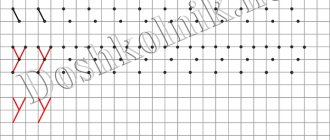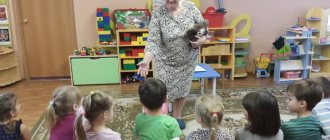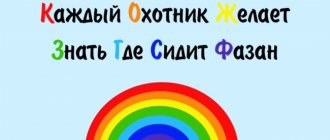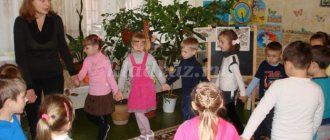TRIZ elements in literacy lessons. article on the topic
TRIZ elements in literacy lessons
Among the goals set for modern school education, the formation of an individual who is capable of solving the tasks assigned to him in a market economy, in particular, quickly finding the most optimal and effective solution to the problem being overcome, stands out. This goal is aimed at realizing the student’s internal potential, developing his creativity, productivity of thinking, which should precisely contribute to the development of the ability to cope with the tasks listed above.
Practice has shown that traditional forms of work cannot fully solve this problem. It is necessary to use new forms, methods and technologies.
One of the effective pedagogical technologies for developing creativity in children is TRIZ - Theory of Inventive Problem Solving. It originated in our country in
50s through the efforts of the outstanding Russian scientist, inventor, writer - science fiction writer Genrikh Saulovich Altshuller. TRIZ is a unique tool for searching for original ideas, developing a creative personality, proving that creativity can and should be taught.
TRIZ for primary school students:
is a system of collective games and activities designed not to change the main program, but to maximize its effectiveness.
- this is “a controlled process of creating something new, combining precise calculation, logic, and intuition,” as the founder of the theory, G.S. Altshuller, believed.
“The main difference between TRIZ technology and the classical approach to school development is to give children the opportunity to independently find answers to questions, solve problems, analyze, and not repeat what adults have said.” Any inventive task is the identification and resolution of a contradiction.
TRIZ technologies, as a universal toolkit, can be used in almost all types of activities (both educational, and in games, and routine moments). This allows us to form a unified, harmonious, scientifically based model of the world in the child’s consciousness. A situation of success is created, the results of the decision are exchanged, the decision of one child activates the thought of another, expands the range of imagination, stimulates its development. Technology gives each child the opportunity to show his or her individuality and teaches unconventional thinking.
Teaching literacy to schoolchildren is a process of mastering their native language, which aims to teach children to speak meaningfully, to instill attention and interest in the sound, syllabic and verbal composition of units of language and speech.
Literacy teaching is based on a single algorithm, which reflects the hierarchy (generalized model) of the Russian language - from sound to syllable, from syllable to word, from word to sentence, from sentence to text. For each step of the algorithm, creative exercises, tasks, games, which are repeated with increasing complexity from lesson to lesson, while the content changes depending on the sound and letter being studied. On the one hand, this creates the illusion of “familiarity” in children, and, therefore, gives them confidence in their abilities, and on the other hand, it presupposes a sufficient level of novelty for the student, which the elements of research activity used in the lesson help to support.
One of the effective means of preparing for teaching schoolchildren to read and write is the use of elements of the theory of inventive problem solving (TRIZ).
The use of TRIZ methods and techniques contributes “not only to the formation of language orientation mechanisms at the appropriate level of language (syntactic, lexical-semantic, phonetic), but also reveals the creative potential abilities of each child, on which the quality of knowledge acquisition, the ability to think outside the box depends, and ensures further successful schooling."
To do this, it is advisable to use games and exercises using TRIZ methods and techniques, such as the method of contradictions, system analysis, Lull circles, analogies, modeling with little people:
Mastering the sound composition of a language and the syllabic structure of a word involves working in the following areas: correct pronunciation of vowels and consonants; development of phonemic hearing by distinguishing sounds during pronunciation in words; improving diction, clearly pronouncing a word syllable by syllable, determining the number of syllables in a word, determining the place of a sound in a word (beginning of the word, middle, end); work on intonation and expressiveness of speech.
Let's look at some techniques and methods.
1.Methods of analogies (synectics):
— visual aid “Aquarium” (tables with multi-colored letters indicating vowels and consonants, their characteristics of hardness - softness, sonority - deafness);
- “Sound mosaic” (initial familiarization with the concepts of “sound”, “letter”, “syllable”, “word”, “sentence”);
- “Enchanted letters” (alternate paired overlapping of strips of paper on which elements of letters are drawn, which when merged form a whole letter; children can form syllables, words, phrases, sentences from the guessed letters);
- “Letters and numbers” (fixation and coding of letters and numbers in figurative form on a sheet of paper);
- “Ringing bell” to familiarize yourself with hard and soft consonants;
- “Our Train” (a train with syllabic carriages and unusual wheels, where soft sounds are indicated by two lines, hard sounds by one line, and a vowel sound by a circle, preparing for sound-letter analysis of words; a train that travels from the city with carriages with closed syllables, and to the city - with carriages with open syllables);
— “Magic Flowers”, “Syllable Flower” (each petal has a hissing sound; each petal has syllables);
2. Circles of Lull:
— “Color wheel”, consisting of 8 sectors with images of pictures on a specific topic. Children find those words that begin with a given sound, which can be located anywhere in the word (beginning, middle, end); words consisting of 2 (3) syllables;
- “Sound Wheel” (similar to the Circles of Lull manual for studying and singing vowel sounds and syllables); “Houses” (for familiarization with dull consonant sounds - houses with closed windows; houses - friends for paired consonant sounds); “Cheerful butterflies” (sonorous sounds are “placed” on the wings of butterflies);
3. Trial and error:
- “Lay out a letter” (letters are laid out from pebbles, identical buttons, etc., according to a given pattern);
4. Modeling method with little people: (allows you to model vowel sounds, soft consonants and hard consonants, voiced consonants and voiceless consonants with a suit of a certain color, lip position, absence or presence of a bell).
Work on the word includes clarification, enrichment and activation of children's vocabulary. For this purpose, the following methods and techniques are used:
1. Circles of Lull:
- “Geographical compass” (the rotation of the arrow indicates the letter with which the word should begin, the second indicates what part of speech the invented word will be or what letter it will end with);
2. Brainstorming:
- “Curious” (the letter with which answers to the driver’s questions “Who?”, “Where?”, “When?”, “Why?”, etc.) should begin;
- “Letter replacement” (changing the original word using one letter); “Encryptors” (reverse writing and reading of words, for example, cabbage - atsupak);
- “Funny transformations” (starting from the initial word, players must arrive at the given one, changing one letter at a time, without shortening or lengthening the word, so that each time they get something new, but not meaningless);
- “Chain of words” (it is proposed to create a chain of words so that each subsequent one begins with the sound on which the previous one ends); “Letters are sorceresses” (in the middle of the sheet or board, one of the players writes a letter, and each subsequent participant writes one letter on either side so that the result of the game becomes a word);
Work on the verbal composition of sentences includes teaching children the correct agreement of words in a sentence, determining the verbal composition and order of words in a sentence.
To solve these problems, the following games with TRIZ methods are used:
1.System analysis:
- “Let’s change” (children make an object, give it certain functions, and then there is an exchange of functions, the children explain how they will perform the function);
- “Wonderful screen” (“nine-screen”) – systematic reflections on any object (properties, relationship with other objects, transformation in time);
- “Binome of fantasy” (using prepositions, conjunctions, cases, you need to establish relationships between two objects that are distant from each other by semantic meaning).
2. Brainstorming:
- “Telegram” (you need to quickly compose the text of a telegram, each word of which begins with one of the letters of the named word and always in the same order);
- “New stories” (with the help of short words, which become the source of the name, you can come up with stories and fairy tales. The word is divided into sounds, and for each of the sounds words are selected with which sentences are made);
- “Acrostics” (riddle poems, where the first letters of each line form a word);
- “Why did this happen” (establishing causal connections between events that at first glance are unrelated and composing a sentence that combines these words in meaning);
- “Get to know me” (describing an object without naming it);
3. Typical fantasy techniques:
- “With the world according to the letter” (writing a more or less coherent story, in which there would be from 8 to 15 words starting with one letter, for example, “The cat pecks at the cranberry”; coming up with only three-, four- or five-letter words with a certain number of syllables, for example, “Our garden is bare”).
Thus, the use of TRIZ methods and techniques contributes to the formation of ideas about a sentence, its verbal composition, the sequence of words in a sentence, develops the ability to divide two- and three-syllable words into parts, compose words from syllables, and isolate the sequence of sounds in simple syllables.
The use of the TRIZ system in teaching literacy contributes to raising a child who is creatively developed, proactive, liberated, with a high level of development of cognitive abilities, general educational skills and abilities necessary for successful learning in primary school.
The skillful use of TRIZ techniques and methods successfully helps to develop inventive ingenuity, creative imagination, and dialectical thinking in younger schoolchildren.
I use this technique in my lessons.
TRIZ elements in literacy lessons.
The game “My Friends” is used by me in the system. We take words with the letter being studied. This game helps me practice children's skills such as division into syllables, stress placement, and the sound composition of words. This game also makes it possible to accumulate knowledge about parts of speech, about nouns (gender, number, proper and common nouns, animate and inanimate objects). So, for example, in the lesson “Reinforcing what has been learned” (after learning the letter “el”), the children can be offered the following words:
— eye table salt distance bread maple bream wolf
— waltz chair elephant falcon salute baby Volga fork
- walk salad woodpecker kalach drop watering can bark plum
The words are printed large on cards and distributed to children (each student receives his own word). To “my friends” the teacher invites students who have words with the following characteristics:
- Sound [l] at the beginning of a word (bark)
- The sound [l] in the middle of a word (eye, wolf, elephant, baby, Volga, fork, salad, kalach)
- The sound [l] at the end of a word (table, chair, falcon, woodpecker)
- The sound [l'] at the beginning of a word (bream, watering can)
- The sound [l'] in the middle of a word (bread, maple, waltz, fireworks, walk, drop, plum, palm tree)
- The sound [l'] at the end of a word (sol, dal)
- Monosyllabic words (eye, table, salt, distance, bread, maple, bream, wolf, waltz, chair, elephant)
- Two-syllable words (falcon, salute, baby, Volga, fork, walk, salad, woodpecker, kalach, drop, watering can, bark, plum, palm)
- The stress in two-syllable words falls on the first syllable (falcon, Volga, fork, woodpecker, drop, watering can, bark, plum, palm tree)
- In two-syllable words, the second syllable is stressed (salute, baby, walk, salad, kalach). • The first sound is unvoiced (table, salt, bread, maple, chair, elephant, falcon, fireworks, salad, kalach, drop, plum, palm tree)
- The first sound is ringing (eye, distance, bream, wolf, waltz, baby, Volga, fork, walk, woodpecker, watering can, bark)
- The first sound is soft (bream, fork, woodpecker, watering can)
- Five letters and one syllable (waltz)
- Four letters, and one syllable (eye, table, salt, distance, bread, maple, wolf, chair, elephant)
- Words answering the question who? (bream, wolf, elephant, falcon, baby, woodpecker)
- Words that answer the question what to do? (walk, bark)
- The first sound is unpaired, unvoiced (bread)
- Words that are written with a capital letter (Volga)
- Words containing consonants that always denote hard consonants (baby)
- Words containing consonants that always denote soft consonants (bream, kalach, leika)
- Words in which the last sound is voiced (table, salt, distance, maple, chair, elephant, falcon, woodpecker).
When playing this game, students are very active and interested. The word “friends” finds a positive emotional response in children. Therefore, during this game, first-graders are in a very good mood, they do everything with joy and pleasure. With this attitude to learning, knowledge is absorbed better and more firmly. Children are constantly on the move and do not need physical activity. Many people have time to think for themselves and check others. In order for everyone to participate in the work, you can invite passive students to read the words with which the children come to the board. The first time is never without mistakes. Children explain, prove, and argue each mistake themselves.
The ability to compare objects (in our case these are words) and find similar features is gained by using the game “Teremok”. My students really like this game, but it takes a lot of time to play. Children have to compare a large number of objects in the game “I’m Taking You with Me.” It is very important that children need to retain in memory the signs named by other children. I also regularly use piggy banks. In literacy lessons we accumulate:
- proper names (then we will make card indexes of words from them: names of children, names of cities, names of states, surnames, first names and patronymics of famous people)
- words with ZHI-SHI combinations (we use words to make sentences for the game “My Friends”)
- antonym words (we use them in creativity lessons to write riddles)
- nouns with vowels e, e, yu, i, denoting two sounds (after vowels)
I often use the “Yes-No” game, which teaches systems thinking. Basically we guess letters. Cross-cutting questions greatly develop children's thinking and help them master various concepts that they learned about in literacy lessons.
To summarize, I would like to note that, as a teacher myself, it is very interesting for me to conduct literacy lessons using the material proposed by A.A. Nesterenko within the framework of TRIZ technology. Children always work very actively in lessons, enjoying their work, developing their speech and thinking.
Literature:
1. Belobrykina O. A. Speech and communication. - Yaroslavl, 2002.
2. Literacy classes at educational institutions / author-compiler L. A. Kuleshova - Voronezh, 2005.
3. Alla Nesterenko (Selyutskaya) Knowledge Workshop: problem-oriented learning based on OTSM-TRIZ. - Moscow 2013





